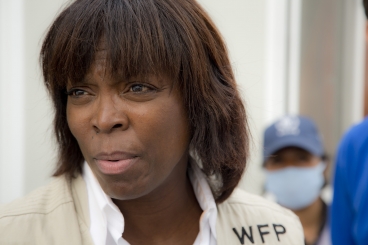 WFP must reach 1.4 million people; but not just with food – survivors urgently need tarpaulins and tents, as well as water purification tablets which WFP will help deliver for our humanitarian partners.
WFP must reach 1.4 million people; but not just with food – survivors urgently need tarpaulins and tents, as well as water purification tablets which WFP will help deliver for our humanitarian partners.
Nepal is home to eight of the 14 tallest mountains on the planet. I’ve just returned from three days there. In my job, I see a lot of disasters, but the devastation in Nepal against the backdrop of its natural and cultural beauty was particularly heartbreaking. Centuries-old Patan Durbar Square, a UNESCO Heritage Site in Kathmandu, reduced to rubble. The majestic foot “hills” of the Himalayas suddenly a looming obstacle to a complex aid operation rather than a hiker’s challenge.
Earthquakes are perhaps the most overwhelming of natural disasters – the ultimate “sudden-onset emergency”. Seismologists have long described the Kathmandu Valley as the most dangerous place on earth when it comes to earthquakes. Experts knew it was only a matter of time before the straining tectonic plates under this beautiful country shifted. We knew an earthquake might occur and we knew the ensuing aid operation would face significant logistics challenges. So the World Food Programme (WFP) – with Nepali government and donor support – prepared for just this scenario. Just weeks before the earthquake struck we opened a relief hub for the entire humanitarian community at Kathmandu airport.
Relief Hub Preparedness = Faster Response
At the time it looked rather dull—a large empty lot stocked with mobile storage units that could be set up swiftly and a few empty prefab offices. But in the hours after the quake struck Nepal this investment quickly demonstrated its practical worth, becoming the nerve centre for the unloading and swift dispatch of planeload after planeload of humanitarian cargo. Thankfully, the UK Department for International Development (Dfid) had the foresight to recognize the value of being prepared and funded this project.
The impact of the devastation, even with all our projections and planning, becomes clearer when you see how far it stretches beyond Kathmandu. To better understand the scale of logistics challenges we are facing, I flew over some of the worst-affected areas.
The juxtaposition between the magnificent landscape and the earthquake destruction is a punch in the stomach, even to a seasoned humanitarian. Heaps of stone and mud where houses had once stood; women and children living out in the open on remote mountainsides. The needs are enormous. WFP must reach 1.4 million people; but not just with food. Survivors urgently need tarpaulins and tents, as well as water purification tablets and WFP will help deliver these for our humanitarian partners.
WFP Assists Enormous Needs of Survivors
Delivering supplies exemplifies the teamwork required for a successful Nepal earthquake response. As the leader of the global Logistics Cluster, it’s WFP’s responsibility to provide this and other logistics support to the entire humanitarian community. To fulfill this responsibility we’ve hired a fleet of trucks which will provide transport for areas reachable by road. Nepal’s unique geography, rain, aftershocks and landslides means many affected communities are inaccessible by road. For the most remote and hardest-hit areas, like the ones in Gorkha district, the quake’s epicentre, helicopters currently provide the only transport option. Helicopters are an expensive way to deliver aid, costing as much as seven to eight times more than road transport, so we must once again call upon the generosity of the entire global donor community to support the WFP response effort.
This all sounds bleak – and indeed this is a situation of fantastic complexity and challenges. But from what I witnessed of the Nepalese people and their strength, I am encouraged. I met with the most senior Nepali government officials and each one of them reiterated a commitment to relieve the suffering of every Nepali citizen affected by the quake. In each meeting we also acknowledged that the clock is ticking and working against us all. That clock is counting down the four to six weeks before the start of the annual monsoon rainy season. Each one of us agreed that overcoming these hurdles will require cooperation and coordination between the government and the humanitarian community.
Together in the Nepal Earthquake Response We Reach Higher
WFP’s own staff – many of whom lost loved ones and their homes – were ready to get to work on the very day the earthquake hit. On my second day in Nepal, I had the privilege of meeting the Seven Summits Women Team – an exceptional group of women who give me great hope for the future of Nepal. They are the first all-female team to climb the highest mountain on each continent. Extraordinary women with boundless vision for themselves and their country. Each woman came from an ordinary or even challenging upbringing. One of their members, Nimdoma Sherpa, received WFP meals when she was a schoolgirl. Their motto, which has taken them so far, also fittingly applies to our collective Nepal emergency response: Together We Reach Higher.

